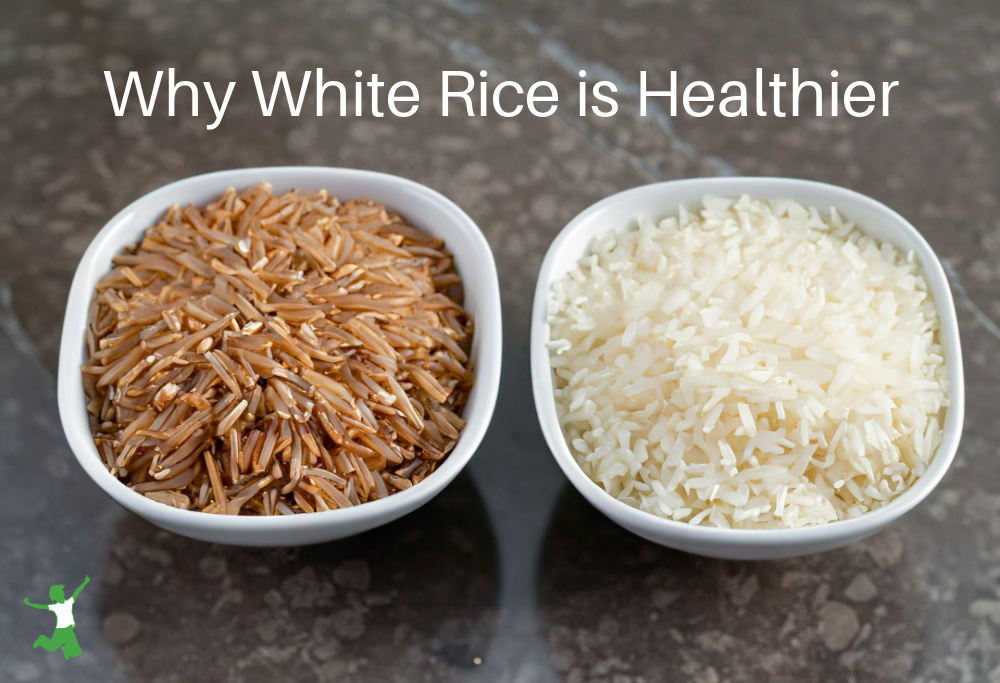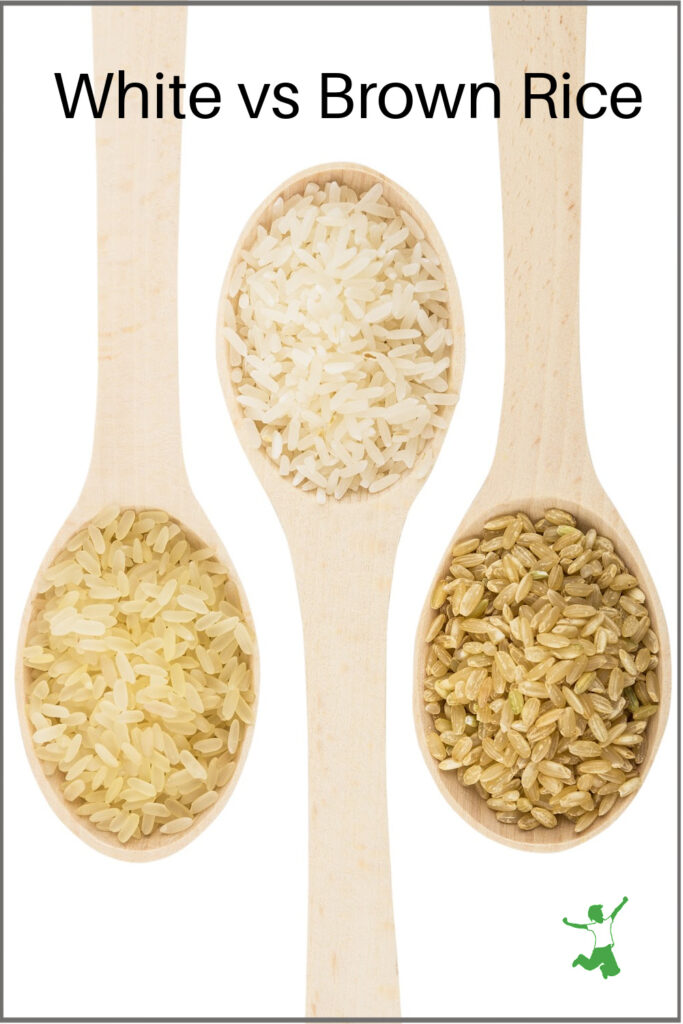The reasons white rice is healthier than brown rice as determined by research as well as which type traditional societies preferred consuming.

My article and video on healthy Chinese food drew some comments from readers who questioned my choice of rice.
Why was I using white rice vs brown? Isn’t brown rice the healthier choice, after all?
Ok, I’ll spill the beans, rice. Here are my reasons …
The truth is, neither my husband nor myself have ever enjoyed brown rice (although we love the nutty flavor and digestibility of wild rice).
Every time we eat brown, it just seems to not sit very well in our stomachs.
Even when it is sprouted or soaked before cooking, it, well, uh, sits like a brick for lack of a better word.
Why Some People Should Eat White Rice
White rice just seems to digest a whole lot better for us. That to me was reason enough to choose it over the brown rice.
We were also advised by an Ayurvedic MD back in the 1990s to stick with white basmati rice. This recommendation clinched the decision.
You are what you digest, after all – not necessarily what you eat!
End of story? Well, not quite.
Rice Fiber in Brown Harms a Compromised Gut
A few years back at the annual Wise Traditions Conference, I became familiar with a compelling book called Fiber Menace.
The author writes extensively about the dangers of a high-fiber diet as it pertains to a menu loaded with whole grains as pushed by the misguided Food Pyramid.
In other words, folks who eat a bowl of All Bran every morning to keep the bathroom visits regular are unknowingly ripping their insides to shreds.
The basic premise of Fiber Menace is that grain fiber plays a leading role in many gut-related ailments including colon cancer.
When I first learned of this information, my preference for white rice over brown rice started to make more sense.
Perhaps the brown rice didn’t digest that well because of all that fiber?
Chalk one up for the white rice.
White Rice Far Lower in Phytic Acid
A second piece of information came from author Ramiel Nagel.
In his book, Cure Tooth Decay, he writes about the devastating effects of phytic acid in the diet. Phytic acid is a very powerful antinutrient and blocker of mineral absorption in the gut.
Mr. Nagel identifies brown rice as very high in phytic acid.
What’s more, soaking brown rice does not reduce phytic acid by much at all!
Polished Rice is the Ancestral Form
Ramiel also maintains that the traditional method for preparing brown rice is never to eat it whole (with only the husk removed).
Rather, ancestral societies pounded brown rice in a mortar and pestle to polish it by removing the outer bran layer. This is the primary source of the phytic acid.
Nagel goes on to point out that experiments have shown that the milled and polished rice that results from this pounding process, has the highest mineral absorption.
In short, mineral absorption from whole brown rice is much less than white polished rice. This is because the phytic acid in the bran which is not reduced much by soaking, greatly interferes with the absorption process.
What About Arsenic?
A big issue with arsenic contamination in rice has emerged in recent years. Some folks have responded by no longer eating rice at all.
This is an overreaction, in my view.
Clean rice is definitely available if you know what to look for.
This article on how to avoid arsenic in rice details what to do. While soaking brown rice barely moves the needle on phytic acid, soaking white rice before cooking removes nearly all the arsenic!
Another option is to parboil white rice before using fresh water for a full cook if you don’t have time to soak.
Is White Rice Better Than Brown?
So it seems that brown rice is not necessarily a healthier choice than milled white rice.
Black or red rice would fall into the same category.
Obviously, whether you choose one or the other is a personal preference, but I hope this information helps you sort through the decision with a bit more clarity.
As for me and my family, we will be sticking with white basmati and jasmine rice (white basmati rice is more nutritious than plain white rice).
I currently buy this brand of rice in 25-pound bags as the most economical and high-quality choice.
Observation clued me in many years ago that brown rice was not something that was sitting well in my stomach or my husband’s.
As the years go by, more research is coming forth to indicate that this decision was the right way to go after all.
Do you eat white rice or brown rice in your home? Why or why not?

References
(1) Fiber Menace
(2) Living with Phytic Acid
More Information
Macrobiotic Diet and Extreme Vitamin D Deficiency
Tiny Teff Grains Deliver Big on Nutrition
How to Make Perfect Yellow Rice (Arroz Amarillo)
Millet: Healthy or Not?
Do Whole Grains Cause Cavities?







this helps me overcome the huge guilt i have for letting my kids eat white rice everyday. raising my family in indonesia makes it nearly impossible not to. ♥ now how to get rid off all the msg that sneaks its way into our food over here!? arrrrg…
Can you help me understand? I have followed your blog for a long time and have come to the conclusion that “less processing” of foods the better. Closer to nature, the better. But that blows that theory to H*** regarding the brown/white rice blog. What you’re saying sounds good but how do you explain that white rice is not closer to nature than brown rice??? Thank you.
if you dont have the (brown) part than you need to complete the rice protein.
I thought as long as you soaked the brown rice long enough with something acidic to reduce the phytic acid, it would be ok. No? This is confusing.
Anyone tried Congee? This is a way to cook a small amount of rice in a slow cooker with a large proportion of water for a long time. The rice balloons up and explodes making a porridge like soup. It tastes very nice and feels very good eating it.
In this process, I have found the husks to be somewhat of a curiosity. There are less husks consumed than in a portion or normally cooked brown rice, but they don’t seem to add anything to the soup. They taste more like the husks on popped popcorn.
Glad to read all the controversial articles! 🙂
Two of my children suffer from mineral deficiencies. They were getting occasional baked goods made from brown rice flour, but after I heard about the phytic acid I switched to white rice flour. That one change seems to have made a significant difference — they’ve been much more content lately.
How do you tell if children suffer from mineral deficiencies?
It was recently in the news of the high levels of arsenic in brown rice, particularly in the outsides, and after telling that, the nurse who was speaking said that we have absolutely no reason to worry about consuming it regularly…Whaaat? As for me, I’m going to have a little concern and although we do not eat much grains, we will go with white rice instead of brown.
Deborah,
I would worry. I wish I knew what I ate in the days prior to my medical testing for work this year. I had arsenic, cadmium and cobalt in my urine. No levels were above the supposed levels of concern. I eat a lot of mexican food, and often cilantro and other greens, but rarely eat the rice. I don’t know if I ate something toxic, or was exposed to something toxic (hair dye the week before?) or if I ate a chelator. Nobody else that I work with had ANY detectible levels in their test results. I’m supposed to be the healthy one. What gives???
probably a supplement.
Turns out, white rice is also lower in arsenic. I am disturbed by the recent news that rice takes up arsenic from the soils and stores it, which is then possibly absorbed by your body. Not cool. And the FDA of course, has not said what level is safe to eat. I wonder if they have tested any human beings to see if they have high levels. No clue. But either way, this further validates your story.